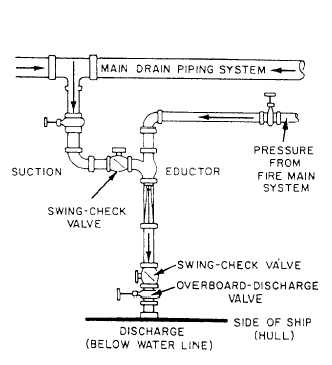Figure 9-13.—Eductor.
Jet Pumps
The pumps discussed so far in this chapter
have had a variety of moving parts. One type of
pump you find in the engine room is the jet pump,
usually called an eductor. Figure 9-13 shows an
eductor, which has no moving parts. These pumps
are used for pumping large quantities of water
overboard in such applications as pumping bilges
and dewatering compartments. As an engineer,
you will think of eductors as part of the main and
secondary drainage system; you will also become
familiar with them as part of the ship’s damage
control equipment.
Eductors use a high-velocity jet of seawater
to lower the pressure in the chamber around the
converging nozzle. Seawater is supplied to the
converging nozzle at a relatively low velocity and
exits the nozzle at a high velocity. As the seawater
leaves the nozzle and passes through the chamber,
Figure 9-14.—Typical eductor system.
air becomes entrained in the jet stream and is
pumped out of the chamber. Pressure in the
chamber decreases, allowing atmospheric pressure
to push the surrounding water into the chamber
and mix with the jet stream. The diverging nozzle
allows the velocity of the fluid to decrease and
the pressure to increase; the discharge pressure is
then established.
Figure 9-14 is an example of a typical ship-
board eductor system. Note that the eductor
discharge piping is below the water line. The
swing-check valve above the overboard-discharge
valve prevents water from backing up into the
system if the system pressure drops below the
outside water pressure. To prevent engineering
spaces from flooding, you must follow the
step-by-step procedures that are posted next to
eductor stations.
ALIGNMENT OF SHAFT
AND COUPLING
When you install or assemble pumps driven
by electric motors, make sure the unit is aligned
properly. If the shaft is misaligned, you must
realign the unit to prevent shaft breakage and
damage to bearings, pump casing wearing rings,
and throat bushings. Always check the shaft
alignment with all the piping in place.
Some driving units are connected to the pump
by a FLEXIBLE COUPLING. A flexible coupling
9-10




